Bitcoin has dropped in half from its all-time high. Many predicted that its deflationary nature caused by the reward halving would push its price to $100,000 or more. But now, the crypto has been trading sideways for over a month and people are beginning to wonder if there’s a looming bear trap or if the bull market will continue.
Don’t miss out on how smart money is playing the crypto game. Subscribe to our premium newsletter – Crypto Investor.
There are various fundamental trends going on with Bitcoin trading and within its blockchain that can provide some insight into what direction the crypto may go in the next few weeks or months.
Exchange Supply
One piece of data that can give an insight into how Bitcoin investors are behaving is where cryptos are moving on and off exchanges. Typically, if Bitcoin is sent to an exchange it is for the purpose of selling. When Bitcoin is sent out of an exchange it can generally represent the act of a purchase and the withdrawal to a personal wallet.
Looking at how cryptos flow in and out of exchanges can reveal broader trends. Lower supplies on an exchange can cause lower liquidity for trading, leading to a scarcity effect that may push the price higher. According to Viewbase, a site that aggregates data from over 14 of the top exchanges, nearly 10,000 Bitcoins were sent to exchanges in the last 30 days. This inflow to exchanges, likely for the purpose of selling, corresponds with the recent downtrend that Bitcoin has experienced.
More recently, however, supply on exchanges has decreased, which has been reflected by stabilization and support above the $30,000 mark. In the last seven days, over 13,000 Bitcoins have been removed from leading exchanges and in the last day, almost 6,000 Bitcoins have left exchanges.
The price of Bitcoin has reflected the movements of Bitcoin from exchanges as Bitcoin has held closer to $35,000 in the last two weeks.
HODLER Accumulation
Another metric to gain insight on Bitcoin’s market health is the number of addresses that are accumulating Bitcoin. These are simply addresses that are not selling any Bitcoin and are continually adding more to their wallet. When the price of Bitcoin drastically dropped in early May, addresses that were accumulating more Bitcoin shot up.
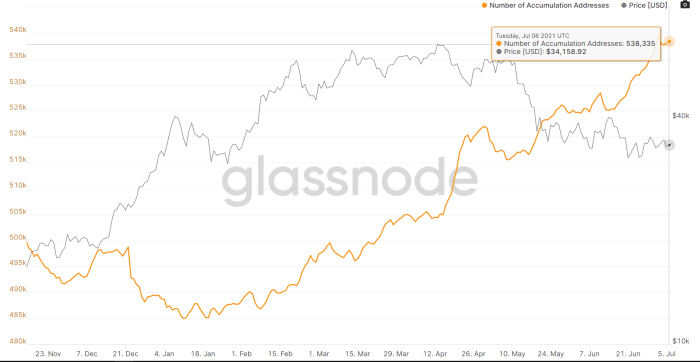
Accumulating Addresses: https://studio.glassnode.com/metrics?a=BTC&category=&m=addresses.AccumulationCount&s=1605415570&u=1625616000&zoom=
This signals a high degree of confidence among Bitcoin holders and shows continued support of the asset regardless of price.
Still In Profit
At Bitcoin’s peak price of around $65,000, almost 100% of Bitcoin wallets were in profit. This means that almost 100% of those holding Bitcoin had purchased the asset at a lower price, which makes sense for a coin that had just reached an all-time high.
At the coin’s lowest price since its drop, 69.5% of wallets were in profit. Currently, just under 74% of wallets holding Bitcoin are in profit. This means that only around 25% of those holding Bitcoin purchased at prices higher than the current price.
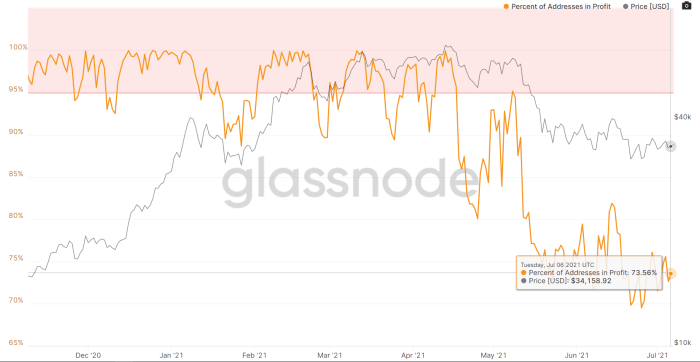
In Profit Addresses: https://studio.glassnode.com/metrics?a=BTC&category=Addresses&m=addresses.ProfitRelative&s=1604842056&u=1625616000&zoom=
When an increased number of investors are experiencing losses, it can lower the overall confidence of the general market. Even though Bitcoin dropped as much as 50% from its all-time high, the vast majority of investors still remain profitable, which is likely another contributing factor to the price stabilizing above $30,000.
Mining Hashrate
The recent mining crackdown in China certainly helped to drop Bitcoin from its highs. Such action from the country caused fear in the market, and we saw newer addresses exit.
But while the fear of regulation can cause sell-offs, this recent drop in Bitcoin’s mining hashrate, or Bitcoin’s total computational power used to mine, could result in a positive outcome.
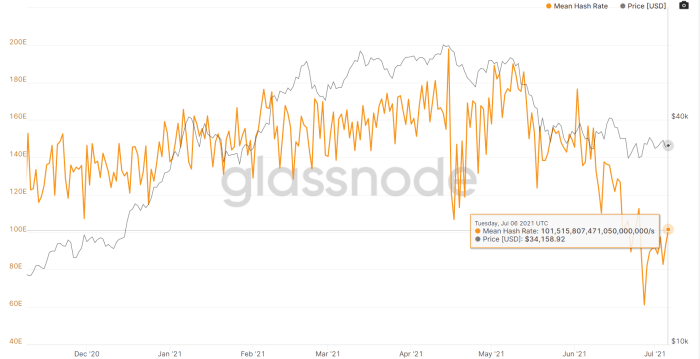
Bitcoin Hashrate: https://studio.glassnode.com/metrics?a=BTC&category=&m=mining.HashRateMean&s=1604842056&u=1625616000&zoom=
Bitcoin has accumulated such immense levels of computer power that it takes up more energy than entire nations. The more energy that gets added to this network the more secure it becomes.
On one hand, it is bad to have a lower hashrate as the network’s security is slightly down. But this decrease in hashrate also represents an opportunity for miners to make more money. A lot more money.
Within the mining infrastructure of Bitcoin is an incentive mechanism. When the hashrate grows the difficulty to mine increases. Typically, a growth in price is followed by a higher hashrate as the increased difficulty has a lessened effect when the price is so high. Should the price drop, or an event like the crackdown in China occur, the hashrate could drop. Then, the protocol will automatically readjust the mining difficulty to be lower. This process ensures that miners always have an incentive to continue and help to make sure the network is always secured.
Right now, Bitcoin’s hashrate has seen a solid drop as many miners in China were forced to shut down. But Bitcoin’s mining difficulty has now plummeted, meaning there’s money to be made for miners.
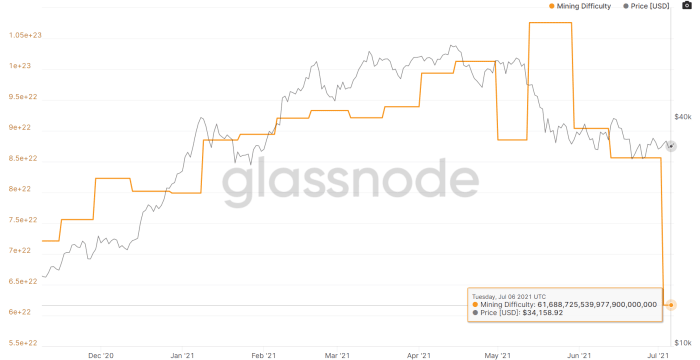
Mining Difficulty: https://studio.glassnode.com/metrics?a=BTC&category=&m=mining.DifficultyLatest&s=1604842056&u=1625616000&zoom=
On June 27, miners received just over 388 Bitcoin for their work. On July 6, after the difficulty had dropped, miners earned over 934 Bitcoin for their work securing the network.
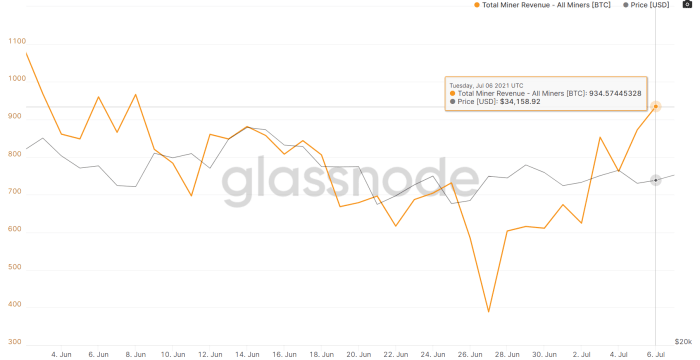
Mining Rewards: https://studio.glassnode.com/metrics?a=BTC&category=&m=mining.RevenueSum&s=1622601120&u=1625616000&zoom=
This period of low difficulty for miners will likely result in very fast recovery for Bitcoin’s hashrate. Overall, the decrease in hashrate can be seen as a positive because fears of China controlling Bitcoin’s hashrate have now evaporated. Now, much of the power coming from China will likely be disseminated to other regions, helping the network spread itself geographically.
So, Is $100k Still in Play?
Much of the $100,000 prediction comes from Bitcoin’s finite supply coupled with the ever-decreasing inflation rate that the asset has. Both of those two factors are still true and will always be true. Without outside variables, and assuming Bitcoin continues getting more use, it would likely continue to scale in price as its finite supply is released into circulation. This model of using Bitcoin’s stock-to-flow ratio has played out well in the past, but the past isn’t always indicative of future results.
What isn’t predictable are outside factors like China’s crackdown or people like Elon Musk, who have incomprehensible levels of influence. While these variables exist and have the power to push Bitcoin off certain trajectories, fundamentals like exchange flows, the confidence of investors who are accumulating, in-profit holders and the incentive for miners to continue securing the network all signal to a continued bull market.




